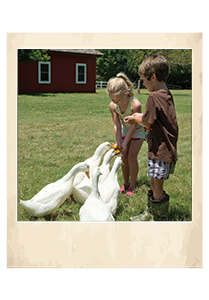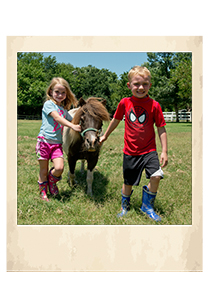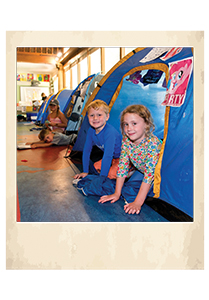The ABCs of Nature
The scene at Keystone Adventure School and Farm is unlike any elementary school you’ve ever seen. It’s a 16-acre working farm in which the learning takes place largely outdoors. Nestled in west Edmond, the site is surrounded by lush landscaping, a spring-fed creek and lots of trees.
 “It’s a great balance between wild areas and manicured areas.” said John Duhon, Keystone founder and educator. “The indoor building doesn’t look like a school—it’s designed to flow like their home, so it’s immediately familiar to children.”
“It’s a great balance between wild areas and manicured areas.” said John Duhon, Keystone founder and educator. “The indoor building doesn’t look like a school—it’s designed to flow like their home, so it’s immediately familiar to children.”
“It’s alive with activity, like a bee hive,” agreed Jenny Dunning, co-founder and educator. “You’ll see pockets of children working together in groups. In some ways, it models the adult workplace—where groups work together and seek help from each other.”
Students of all ages, from three-years-old to fifth graders, work with one another to accomplish group projects—from barn repairs to harvesting. In some aspects, it resembles growing up with a large family on a farm. Each day the students of Keystone feed, groom, clean up after and love on the animals. Some children feed and brush horses while others gather eggs from the ducks, geese, guineas and chickens. The children especially enjoy the baby llamas, born each spring to aptly-named parents, Romeo and Juliet.
Because curiosity is the main component of learning, children bustle around in various states of exploration, helping direct their own learning paths in an organic way, on their own developmental timescale. Daily recess lasts an entire hour.
“Children might be outside climbing trees, building stick houses, digging tunnels in the sand, and if a teacher is on pond duty, they can fish off the dock or ride paddleboats. It’s very active with the sounds of childhood laughter, song and questions,” said Dunning. “If you listen, you also hear pockets of silence where reflection is going on.”
Dunning describes the campus as a place where kids can ‘wander and wonder.’ “Unstructured time outside is valuable, magical. It’s what awakens their sensorial learning systems, calms them and allows them to observe and question their world.”
It sounds fun, but what about academics?
 Formal instruction is intermingled among the work and play of childhood. Each multi-age classroom has 12-18 students per teacher, but only a small percentage of time is spent in age-group lessons. Most of the skill-based instruction takes place one-on-one with a teacher or specialist.
Formal instruction is intermingled among the work and play of childhood. Each multi-age classroom has 12-18 students per teacher, but only a small percentage of time is spent in age-group lessons. Most of the skill-based instruction takes place one-on-one with a teacher or specialist.
“It takes an army of teachers to have such individualization,” Duhon said. “We have specialists who teach art, physical education and technology, plus a variety of assistants. It brings the child/adult ratio to 6 to 1.”
Don’t expect students to undergo standardized testing, however. “We don’t believe in standardized testing, and we aren’t interested in this ‘right answer’ business,” Dunning said speaking emphatically. “The process of questioning, in which the child provides his or her own answer, is what’s important here. Children have to build emotional and social maturity before they begin to build academic understanding—so our students reach the benchmarks, but in a more appropriate way.”
According to Duhon, most schools label children in order to put them into a class where the students can all be taught the same way at the same time. In settings with a set curriculum, a child is either on track, bored or falling behind. Kids who don’t fit into the “right” age group get labeled differently, and then their confidence plummets.
“We embrace diverse learners. The truth is, we all have our own internal timetable, and when you force concepts at an inappropriate time for that child’s timetable—it sends them into self-doubt,” Dunning said. “When they move forward at their own pace, they are actually moving forward. So many parents come to us saying, ‘I want my child back,’ because the labels have caused their child to pull in for protection.”
Over the last ten years, the school has focused on creating a safe environment where students ask questions and solve problems without being spoon-fed the answers. Statements like, “Try again,” and “How can you make that better?” are common.
 “As teachers, our mindset is to interact with the students and facilitate—and then get out of their way as they start discovering. We are in there with them, learning beside them and from them. That’s the beauty of individualized instruction.”
“As teachers, our mindset is to interact with the students and facilitate—and then get out of their way as they start discovering. We are in there with them, learning beside them and from them. That’s the beauty of individualized instruction.”
Dunning admits that this type of teaching is exhausting because they are “covered up with children from 7:45 to 4:30.” They are super picky about who they hire, and no one takes unnecessary breaks. “The teachers go home exhausted, but they come back the next day with fresh openness in their heart.”
“People say that we have great patience and tolerance to work at a place like this—but what we have is a great understanding of what it’s like to be a child. Instead of downplaying childhood and making school an adult-like place, we think it should look like kids are there,” Duhon said.
“From a bird’s eye view, it probably looks like chaos—but that’s what learning looks like,” Dunning said. “It’s an honor to be part of these children’s lives. It is difficult to define joy, but joy erupts from children, and being close to that is a real gift.”
Keystone Adventure School and Farm is located at 19201 N. Western Ave. in Edmond. For more information, visit keystoneadventureschoolandfarm.com or call 216-5400.




